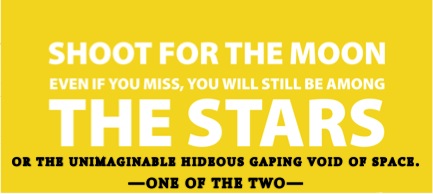That Les Brown quote “Shoot for the moon… even if you miss, you’ll land among

the stars,” may be apropos in certain situations –embarking on a weight loss plan, striving to meet a sales goal, or training for a marathon – but it certainly doesn’t apply to pricing commercial real estate.
In today’s commercial real estate market, shooting for the moon — with inflated asking prices – doesn’t end with a seller in the stars, but rather with a long, agonizing fall back down to earth.
In fact, a review of commercial transactions in the Harrisonburg market area confirms this very different reality. When properties are priced above market value, they linger on the market for much longer and — when they eventually do sell — tend to go for a price that’s lower than the “worst case scenario” price the seller had in mind.
To end up among the stars – otherwise known as the starry glow that results from a sale that nets the highest price in the shortest period of time – sellers should price their buildings properly from the start. Not only does property that’s initially priced at market value tend to sell faster, it also tends to sell at closer to the asking price.
Pitfalls of Overpricing
The common mantra “We can always drop that price later, but we can never come up again…” may be applicable in certain circumstances, such as a market with rapidly appreciating prices and sparse inventory. In today’s market, though, sellers should be prepared for the property to take longer to sell as commercial real estate pricing tests the market’s tolerance and limits.
Sellers are particularly prone to set higher than market prices when the seller’s purchase price enters into the pricing decision. When you or your broker is determining market value, the purchase price is irrelevant, the asking price needs to reflect what the market would actually bear—based on income generated, comparable properties, or both—and not simply what the seller hopes to net.
When asking price doesn’t match market value, sellers should prepare to face a long list of pitfalls such as:
- Decreased number of offers
- Diminished prospects
- Limited financing
- Fewer qualified buyers
- Lower broker response
- Reduced number of site visits
- Seller desperation that leads to hasty decisions
- Less net gain for the seller
Unless a seller gets lucky and comes across that one special buyer with money to burn, an overpriced property is likely to result in fewer offers and discouraged potential buyers who could have afforded the property if it were priced correctly.
In today’s tight lending market – with buyers often required to place a greater percentage down on purchases – not only do buyers need more capital to acquire property, they also need to maintain capital for operations and reserves. When property is overpriced, it disqualifies many potential buyers from the start.
Moreover, today’s buyers are well-educated and sophisticated, a fact that sellers must take into account. Assume that serious prospects have done their homework; they know what the market will bear and they’re not going to waste time making offers on an overpriced property.
Finally, the longer a property lingers on the market, the more it can lead to the worst scenario of all—desperation. Unfortunately there are too many stories of sellers that have employed the “shoot for the moon” strategy only to find the lack of offers or interest unbearable. In many cases, this waiting period seemingly triggers an emotional overreaction that is illustrated by price reductions in an effort to generate some attention from buyers and an eagerness to accept the first offer that comes along for fear another may not. Sadly, the results are the same as most of decisions driven by fear and anxiousness.
Properties that were on the market more than 200 days in 2011 not only had additional carrying and opportunity costs, but they also sold for only 78% of the asking price; and this does not account for previous price reductions, which would widen the ask-to-purchase ratio even more. By contrast properties that were priced appropriately sell quickly, often within 100 days, for 92% of the asking price with few or no price reductions.
A Closing Gap
After the commercial real estate market took a nose-dive in 2008, a significant gap appeared between asking and bidding prices. However, it’s four years on and the chasm has narrowed; in some regions of the country, the gap has all but disappeared.
Smaller markets, like Harrisonburg and many of the communities in the Shenandoah Valley, still lag slightly behind in correcting the pricing gap. The relatively small number of transactions in a given year is a contributing factor since transactions are a substantial portion of the basis for valuation. By monitoring transaction levels, market participants are better able to form market expectations, evaluate prices and develop strategies. Recently, the Harrisonburg area had shown nice improvements with a bid to ask differential of only 13% on completed transactions in 2011.
To generate the highest possible return in a reasonable time, make sure the initial pricing matches current market conditions. Instead of fixating on prices of the past or the purchase price and praying for that one-in-a-million buyer to happen along; be honest with yourself, listen to the research, and price that property right from the beginning.
You May Also Be Interested In–
- Commercial Real Estate Market Reports | Local Information, Local Report, Updated Quarterly
- Resource Center | White Papers, Commercial Real Estate Tips, and Investment Information
- Search for Property | Search for Commercial Real Estate Throughout the Valley.
- About Tim Reamer | Your Position Will Always Be Informed and Well Represented
 Tim Reamer provides commercial real estate brokerage and consulting services specializing in investment property (multifamily | commercial | NNN), retail/restaurant site selection, and general commercial representation.
Tim Reamer provides commercial real estate brokerage and consulting services specializing in investment property (multifamily | commercial | NNN), retail/restaurant site selection, and general commercial representation.